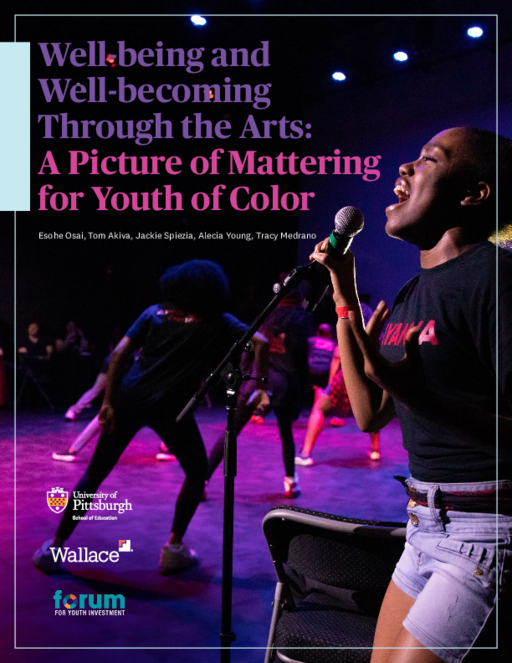- Author(s)
- Esohe Osai, Tom Akiva, Jackie Spiezia, Alecia Young, and Tracy Medrano
- Publisher(s)
- University of Pittsburgh and Forum for Youth Investment
Research Approach
This study took place in eight U.S. cities, each with a unique learning and development ecosystems for youth arts. A total of 35 youth arts programs participated in the study. Four programs per city participated from Tacoma, Oakland/Bay Area, Louisville, Detroit, and Washington, D.C., and five per city participated from Chicago, Newark/Paterson, and Atlanta. The selected cities represent a cross-section of the U.S., including the West, South, Midwest, and East regions. Researchers began with an ecosystem mapping process for each city, relying on web research and interviews with community leaders (i.e., leaders of afterschool intermediaries, arts intermediaries, or directors of large programs) to better understand each city’s local arts ecosystem and to help identify potential programs that fit the study criteria. They identified a set of 35 programs that met the following criteria: (a) a focus on high-quality training in youth arts (dance, theater, visual arts, vocal music, instrumental music, literary arts, or digital and media arts); (b) youth served are a majority youth of color; and (c) program founded and/or led by person(s) of color to serve youth within the community.
After identifying potential organizations, program leaders were recruited and interviewed to learn more about the organization’s practices, goals, and strategies. In the next phase, researchers visited the organization’s sites and conducted 90-minute, cross-age workshops with four to six youth, and two to three teaching artists per site. While the workshops functioned as focus groups, they were highly interactive and designed to be more like youth development activities. A story-telling method was used to learn about youth and teaching-artist experiences within their programs and a card-sorting activity was used to better understand their perceptions about the benefits of the arts. Storytelling was a central methodological approach used in the study’s design, allowing participants to unpack the salient aspects of their participation.
Following site visits, a youth survey was developed and distributed to all youth to gather more insights about youth participation patterns, including how frequently they attended and for what reasons. It also included questions about racial identity, social justice perspectives, and how teaching artists influenced their experience. For the final phase of the study, teaching artists from the programs were invited to participate in a 60-minute virtual focus group, organized by city.

